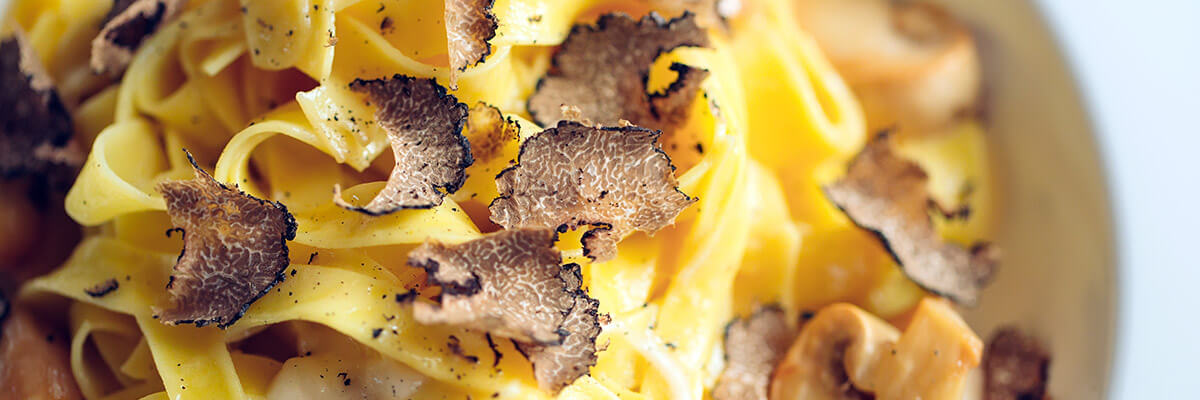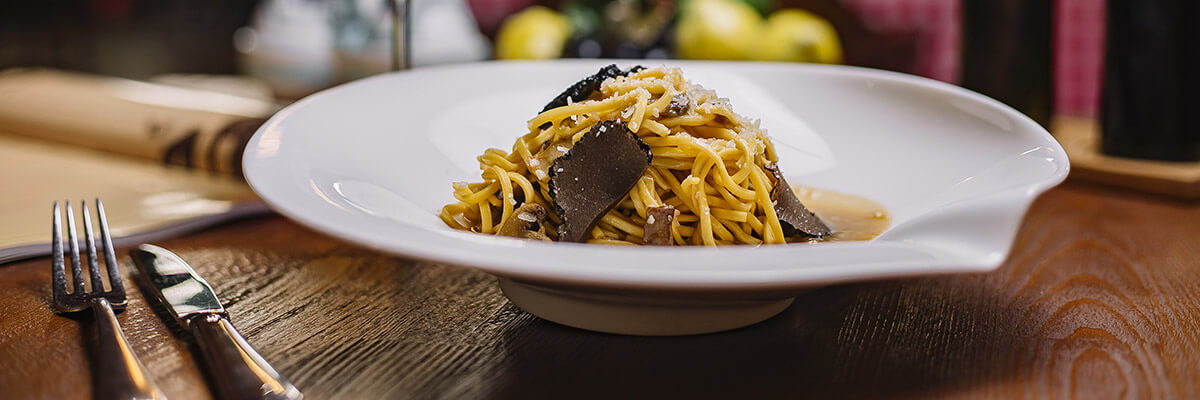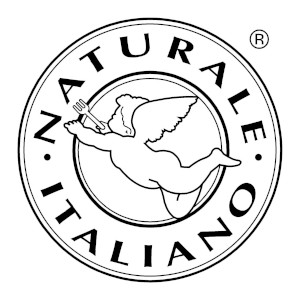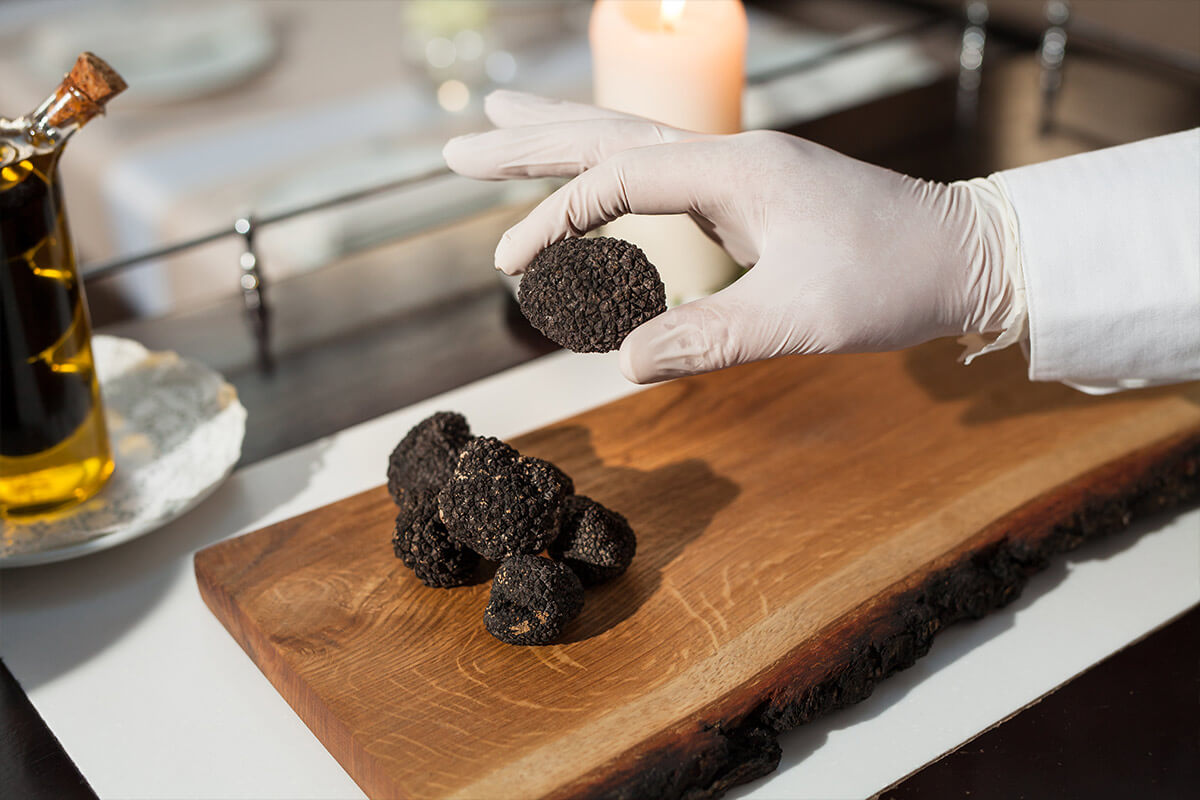When you use quality, high-quality ingredients, the chance of preparing an excellent dinner increases considerably. Of course, the chef's hand is fundamental, but a good start is a good start... Undoubtedly, truffles are one such product that can turn a simple meal into an extraordinary taste experience.
As truffles are very expensive, it is important to be able to distinguish the characteristics of all varieties in order to make the right choice. The next step is not to waste its flavour but to know how to make the most of it, creating dishes and combinations able to enhance its best qualities.
Italian truffle: what it looks like, characteristics and varieties

First of all, the truffle is an underground fungus in the form of a tuber, which lives underground in symbiosis with the roots of certain plants such as oak, lime, hazel, hornbeam and poplar.
"'Gleba' is the name of its fleshy mass, covered by a kind of bark called 'peridium'. It is composed mainly of water, fibre and mineral salts, all organic substances supplied by the tree with which it lives in symbiosis.
Its shape depends very much on the characteristics of the soil in which it grows: for example, a softer soil will favour the growth of a spherical-shaped truffle, while a harder and stonier one will give rise to a more lumpy and irregular shape.
There are three main varieties of truffle, which differ from each other in terms of appearance and harvesting. The most famous are:
- Alba White truffle: better known as Tuber magnatum Pico, it is mainly collected between October and December; compared to the black truffle, it differs not only in colour, but also in its delicious taste and more intense smell. It is also much rarer to find and therefore commands a higher price. Its taste is very pleasant, distinctive and intense, and the aroma it releases when it reaches maturity is strong and satisfying, truly unique!
- Prized Black Truffle: its original name is Tuber melanosporum, and it is collected between November and March; among black truffles, the prized one is the most expensive, although it is definitely cheaper than the White Truffle. Its flavour is very distinctive, almost sweetish, which is why the Black Precious is often also called the "sweet truffle."
- Summer Black Truffle: alternatively, Tuber Aestivum Vittadini or Scorzone Truffle, it is mainly collected between May and December, that's why it is called "summer"; it is considered less precious than the Precious Black Truffle, to non-experts it could appear quite similar to the latter, but actually it is distinguished by its pleasant and delicate aroma, slightly mushroomy, and by its strong but not excessive flavour, which can remind of porcini mushrooms. It is much appreciated and used in the preparation of sauces.
It is important to know and be able to distinguish the various characteristics, especially in the first phase of truffle preparation: the choice.
How to choose truffles
The choice of truffle is one of the most important moments, which will determine whether your dishes are successful or not. You have to consider not only the aesthetic aspect, but also the olfactory and tactile ones. Knowing the characteristics of the product will help you avoid being ripped off, as often truffles of lesser value are passed off as among the best, to the detriment of quality and your wallet.
If you don't have a truffle expert among your acquaintances who can give you advice, we suggest you some indications that can be useful to distinguish a quality truffle from a less valuable one:
- Avoid truffles that are not yet ripe or already rotting: there are not many explanations to add, mould or immaturity cannot be associated with a quality product.
- To the touch, the truffle should show a marked hardness: it is a symptom of freshness of the product; on the contrary, if it is soft and tends to be mushy, it means that it has already passed the maximum phase of maturation and is beginning to create the first mould.
- By smell, it is possible to distinguish between two truffles the most valuable one: here the differences can be very subtle and only an expert nose can be able to distinguish them. In the case of the white truffle, however, if you smell the scent of garlic, hay and honey in a balanced and delicate way, then this means that you are dealing with a perfect product, while if you should smell a slight aroma of ammonia, discard it immediately.
- Make sure the truffle is weighed correctly: in fact, demand that it be weighed accurately, as any slight variation in weight can alter the price; generally, be wary of pricing by the piece
- Find out the average market prices: this is a good starting point to avoid being cheated, especially if you are looking for truffles already 'grated' to use in your restaurant's dishes. Just to give you an idea, about 10 grams of truffle sprinkle can cost no less than 30/40 €, so don't be tempted by cheap offers if you don't want to lose out on quality.
- Always check that the truffle is clean and free of soil: in fact, imperfections can hide under the residues, a good cleaning of the truffle guarantees the transparency of the product and allows you to better evaluate all its characteristics.
By taking advantage of these tips and studying the truffle in depth, you will be able to choose the best products available on the market, without risking cheating due to inexperience. It is one of the most important moments and it is necessary to pay due attention to every detail.
After completing the purchase, it is important not to waste the time and money invested: let's see how to enhance the flavour of the truffle and with which foods its unique fragrance goes best.
How to use truffles in the kitchen

As we all know, the truffle is a highly prized food in kitchens all over the world, and for this reason it must be given the right attention and sparingly. It is essential to find the right combinations, which highlight and enhance aromas and flavours. There are some general guidelines that can be used as a basis when preparing truffles.
Usually, the best combinations are simple ones, with delicately flavoured ingredients. This is to avoid creating excessive contrasts when tasting, risking having the strong flavour of the truffle covered by that of other foods on the plate.
Depending on the type of truffle you are dealing with, it can be used in different ways: for example, white truffles are used raw, grated in thin slivers directly on top of the prepared dish, while black truffles can also be used during cooking, mainly in the final phase.
Among the classic traditional first courses based on truffles, we find the Tajarin or Tagliolini; a typical dish which, like few others, manages to make the most of and enhance the aromas of the precious mushroom. Another must is certainly the truffle risotto, always based on simple and delicate ingredients: if cooked well, it is able to transform a simple dish into a moment of pure enjoyment for the palate. There would be hundreds of other truffle-based first courses to suggest, but we know that you are much better at this than we are, so we will limit ourselves to inspiring you, for the rest, let your imagination run wild!
As far as second courses with truffles are concerned, a good solution is omelettes: eggs, in fact, have a flavour that is not invasive and therefore go perfectly with any type of truffle; the same applies to omelettes and other similar preparations. Another excellent alternative is fillet steak with truffles: the meat can be enriched by the intense flavours of the truffle, as in a typical Umbrian recipe where the fillet is served with the fine black truffle together with porcini mushrooms. As with first courses, it seems pointless to list thousands of recipes. You are the expert, so create the dishes you have in mind and amaze your customers with something unique and exceptional.
With our little tricks you can certainly discover aspects you didn't know about and put yourself in a position to introduce truffle dishes in your restaurant without any nasty surprises. Our recommendation is always to inform yourself as much as possible: experience teaches, but good preparation will help you get off on the right foot.
Don't rely only on traditional dishes, let yourself be inspired by your imagination and your knowledge of the products, with truffles you can create thousands of culinary combinations with a unique flavour, you just have to be brave and experiment, until you have found something that only your restaurant can offer.










